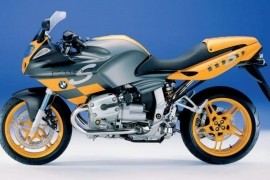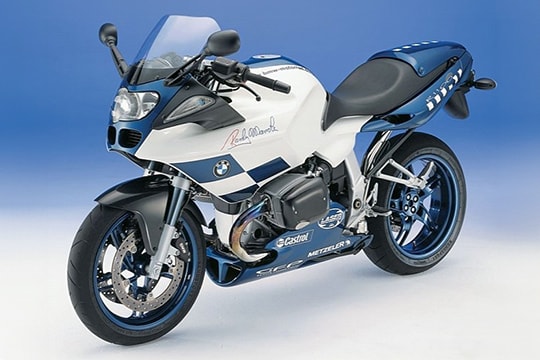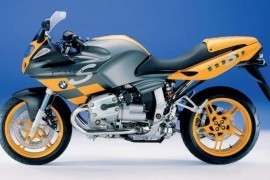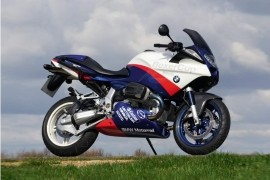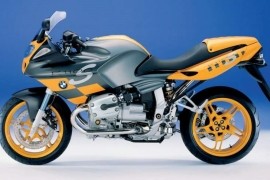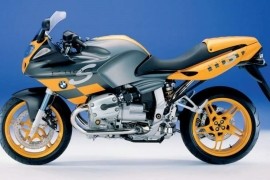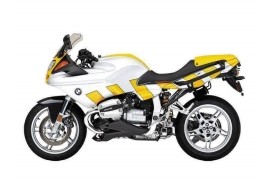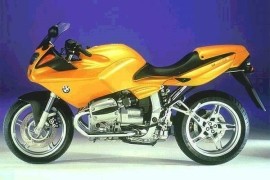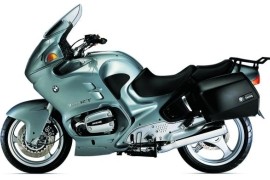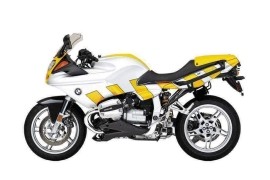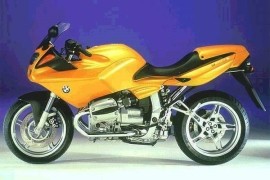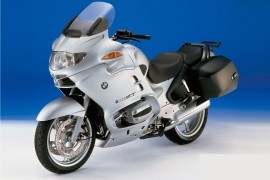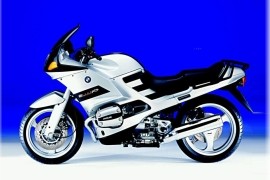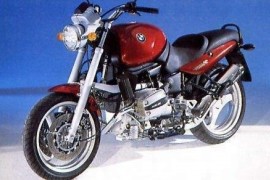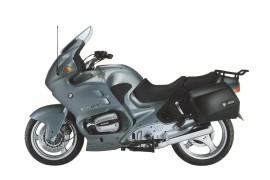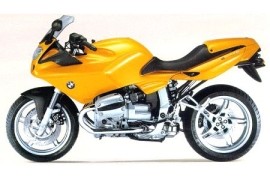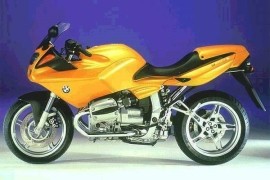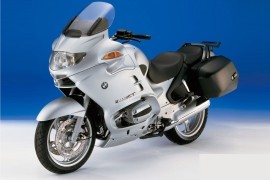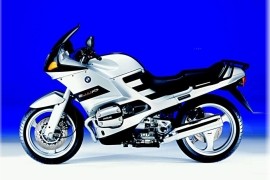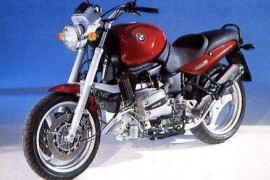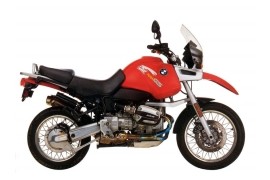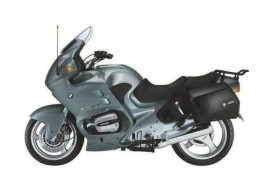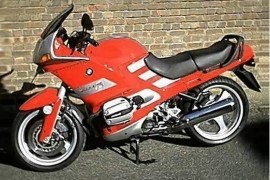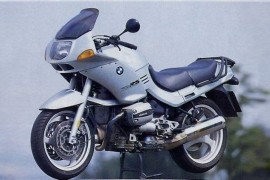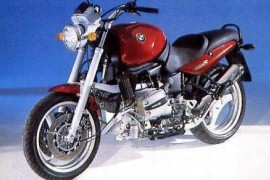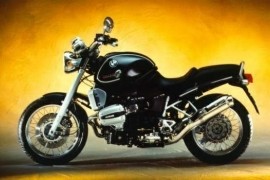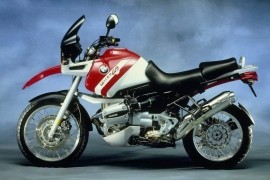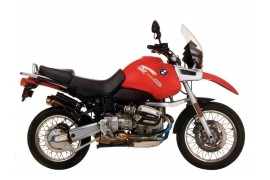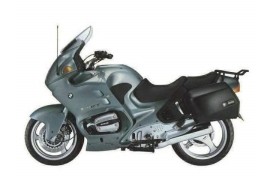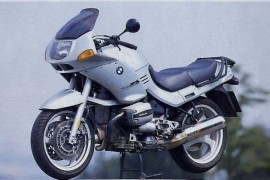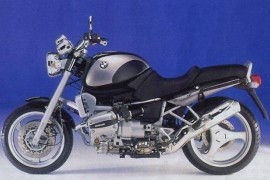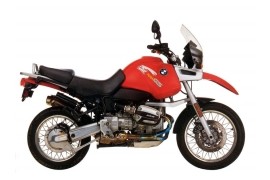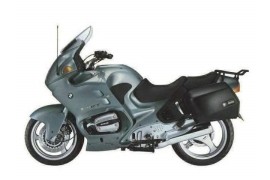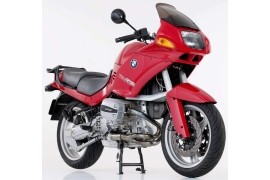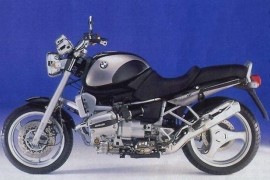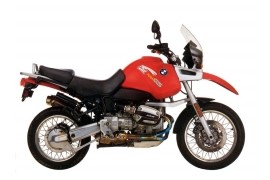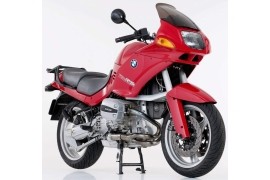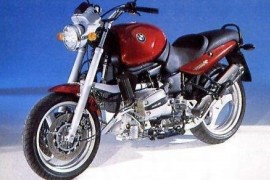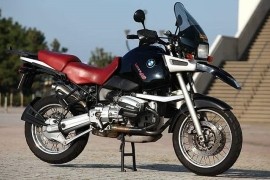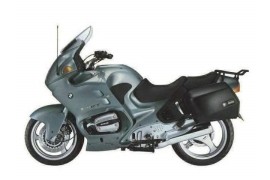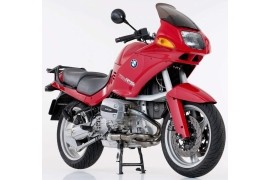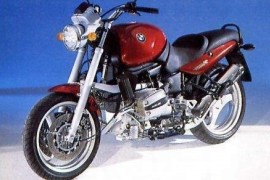BMW R 1100 Models/Series Timeline, Specifications & Photos
First production year: 1993
The BMW R1100S was a sports or sports-touring motorcycle made by BMW from 1998 until 2005, when it was replaced by the BMW R1200S. It was introduced 25 years after BMW's first sports bike, the R90S, and was the first BMW motorcycle that featured a clip-on handlebar, rear set footrests, and a removable passenger seat cover.
When it was replaced by the R1200S in 2005, the R1100S's alloy frame was replaced by a lightweight trellis unit and a tuned engine. The new frame combined with the tuned engine resulted in 13 kg (29 lbs) less and 25 percent more power.
In 2005, the German motorcycle maker released the BMW R1100S, a sport-touring motorcycle in its last production year. It remained largely unchanged over its production period, offering the same specifications without significant modifications.
The bike's appearance was complemented by standard features, such as a half fairing with a windscreen, a one-piece dual seat with a passenger seat cover, an under-seat exhaust system, a single-sided swingarm, and five-spoke aluminum wheels.
The 2005 BMW R1100S was powered by a 1,085cc four-stroke air/oil-cooled twin-cylinder boxer engine, managed by a fuel injection system. It delivered an output power of 98 hp at 7,500 rpm and 95 Nm (70 lb-ft) torque at 7,500 rpm.
As for the stopping power, the motorcycle relied on two 320 mm brake discs mounted on the front wheel and a 276 mm brake disc mounted on the rear wheel. The front ones were coupled to four-piston calipers, while the rear was tied to a dual-piston caliper.
The BMW R1100S was a sports or sports-touring motorcycle manufactured by BMW from 1998 until 2005 when it was replaced by the BMW R1200S. It was introduced 25 years after BMW's first sports bike, the R90S, and was the first BMW motorcycle that featured a clip-on handlebar, rear set footrests, and a removable passenger seat cover.
A more expensive version of the S1100S with more track capabilities was introduced in 2003 under the BMW R1100S Boxer Cup Replica (BCR) designations. The special edition machine featured several tweaks and improvements compared to the standard model.
Some modifications included the twin Laser under-seat exhausts, braided brake lines, a carbon fiber oil-catcher belly pan, carbon fiber cylinder head protectors, Ohlins suspensions, and a shorter Paralever torque arm that raised the rear end and increased cornering clearance.
In addition, the special edition machine came with a special, three-tone paint job and a standard engine management chip, which was swapped at the first dealership with a modified one. Even with the modified one, the bike delivered the same power as the standard or Sport versions.
In 2004, the German motorcycle maker released the BMW R1100S Boxer Cup Replica, a special edition version of the base model with the same specifications as the previous model.
As for power, the 2004 BMW R1100S Boxer Cup Replica had installed a 1,085cc four-stroke air/oil-cooled twin-cylinder boxer engine at its core, boasting 98 hp at 7,500 rpm and 98 Nm (72 lb-ft) torque at 5,750 rpm.
The BMW R1100S was derived from the R1100RS model and debuted in 1998. It was the first BMW motorcycle that featured a clip-on handlebar, rear set footrests, and a removable passenger seat cover.
In 2004, the German motorcycle manufacturer released the BMW R1100S, a sport-touring motorcycle suited for those riders who wanted more performance from their machine but in a lightweight package that also offered excellent comfortability.
The motorcycle's appearance was characterized by standard fittings, such as a half fairing with a windscreen, a one-piece dual seat with a passenger seat cover, an under-seat exhaust system, a single-sided swingarm, and five-spoke aluminum wheels.
The 2004 model came in the same shape and form as the previous model, offering the same technical, visual, and performance specifications without any changes, except for different color options.
In the performance department, the 2004 BMW R1100S delivered 98 hp with maximum force at 7,500 rpm and 95 Nm (70 lb-ft) torque at 7,500 rpm from a 1,085cc four-stroke air/oil-cooled twin-cylinder boxer engine with a fuel injection system in charge.
The power generated by the powerhouse was converted into motion by a six-speed manual gearbox with a dry single-plate clutch linked to the rear wheel via a final chain drive. The bike reached a top speed of 219 kph (136 mph).
The BMW R1100S was a sports or sports-touring motorcycle made by BMW from 1998 until 2005, when it was replaced by the BMW R1200S. It was introduced 25 years after BMW's first sports bike, the R90S, and was the first BMW motorcycle that featured a clip-on handlebar, rear set footrests, and a removable passenger seat cover.
In 2003, a more expensive version of the S1100S with more track capabilities was introduced under the BMW R1100S Boxer Cup Replica (BCR) designations, featuring several tweaks and improvements compared to the standard model.
Some modifications included the twin Laser under-seat exhausts mufflers, braided brake lines, a carbon fiber oil-catcher belly pan, carbon fiber cylinder head protectors, Ohlins suspensions, and a shorter Paralever torque arm that raised the rear end and increased cornering clearance.
In addition, the special edition motorcycle featured a special, three-tone paint job and a standard engine management chip, which was swapped at the first dealership with a modified one. Even with the modified one, the bike delivered the same power as the standard or Sport versions.
As for performance, the 2003 BMW R1100S Boxer Cup Replica had its heartbeat set by a 1,085cc four-stroke air/oil-cooled twin-cylinder boxer engine mounted underneath its fuel tank, boasting 98 hp at 7,500 rpm and 98 Nm (72 lb-ft) torque at 5,750 rpm.
The BMW R1100S was a sports or sports-touring motorcycle made by BMW from 1998 until 2005, when it was replaced by the BMW R1200S. It was introduced 25 years after BMW's first sports bike, the R90S, and was the first BMW motorcycle that featured a clip-on handlebar, rear set footrests, and a removable passenger seat cover.
In 2003, the German motorcycle maker released the BMW R1100S, a sport-touring motorcycle in its sixth consecutive production year. The 2003 motorcycle featured some modifications to the engine.
The engines produced since 2003 had dual ignition with two spark plugs per cylinder. The bike's transmission was derived from the BMW K1200RS, and the top gear offered 32 kph (20 mph) per 1,000 rpm.
In the visual department, the bike was similar to the previous one, packing the same standard features, such as a half fairing with a windscreen, a one-piece dual seat with a passenger seat cover, an under-seat exhaust system, a single-sided swingarm, and five-spoke aluminum wheels.
As for the power figures, the 2003 BMW R1100S boasted 98 hp with a peak force at 7,500 rpm and 95 Nm (70 lb-ft) torque at 7,500 rpm from a 1,085cc four-stroke air/oil-cooled twin-cylinder boxer engine with a fuel injection system in charge.
A six-speed manual gearbox with a dry single-plate clutch as a final shaft drive redirected the power from the engine to the rear wheel, pushing the bike to a top speed of 219 kph (136 mph).
In 2002, the German motorcycle maker released the BMW R1100S, a sports-touring motorcycle created for those riders with zero compromises in performance but also wanted a comfortable machine.
The BMW R1100S was derived from the R1100RS model and debuted in 1998. It was the first BMW motorcycle that featured a clip-on handlebar, rear set footrests, and a removable passenger seat cover.
The bike packed standard features in the aesthetic department, like a half fairing with a windscreen, a one-piece dual seat with a passenger seat cover, an under-seat exhaust system, a single-sided swingarm, and five-spoke aluminum wheels.
The 2002 BMW R1100S was powered by a 1,085cc four-stroke air/oil-cooled twin-cylinder boxer engine, managed by a fuel injection system. It delivered an output power of 98 hp at 7,500 rpm and 95 Nm (70 lb-ft) torque at 7,500 rpm.
The bike's power was transmitted to the rear wheel through a six-speed manual transmission with a dry single-plate clutch and a shaft drive, pushing the motorcycle to a maximum speed of 219 kph (136 mph).
From top speed to a complete stop, the motorcycle relied on two 320 mm brake discs mounted on the front wheel and a 276 mm brake disc mounted on the rear wheel. The front ones were handled by four-piston calipers, while the rear one was engaged by a dual-piston caliper.
In 2001, the German motorcycle maker released the BMW R1100S, a sports-touring motorcycle derived from the BMW R1100RS. Except for color alteration, the bike remained unchanged from previous models, offering the same specifications.
The BMW R1100S was a sports or sports-touring motorcycle made by BMW from 1998 until 2005, when it was replaced by the BMW R1200S. It was introduced 25 years after BMW's first sports bike, the R90S, and was the first BMW motorcycle that featured a clip-on handlebar, rear set footrests, and a removable passenger seat cover.
The bike had installed standard features in the visual department, such as a half fairing with a small windscreen, a dual seat with a removable passenger seat cover, an under-seat-mounted exhaust system, a single-sided swingarm, and five-spoke aluminum wheels.
The front end was controlled by an adjustable BMW Motorrad Telelever fork with 110 mm of travel and two 320 mm rotors with four-piston calipers. The rear end was handled by an adjustable Paralever system with 130 mm of travel and a 276 mm brake disc with a dual-piston caliper.
The 2001 BMW R1100S took its muscles from a 1,085cc four-stroke air/oil-cooled twin-cylinder boxer engine that delivered an output power of 98 hp at 7,500 rpm and 95 Nm (70 lb-ft) torque at 7,500 rpm.
All the power and torque were sent to the rear wheel through a final shaft drive and a five-speed manual transmission that pushed the motorcycle to 219 kph (136 mph).
The BMW R1100S was a sports or sports-touring machine made by BMW from 1998 until 2005, when it was replaced by the BMW R1200S. It was introduced 25 years after BMW's first sports bike, the R90S, and was the first BMW motorcycle that featured a clip-on handlebar, rear set footrests, and a removable passenger seat cover.
In 2000, the German motorcycle manufacturer released the BMW R1100S, a sports or sports-touring motorcycle addressed to those riders who wanted an occasional adrenaline rush in a well-behaved package.
The 2000 R100S came in the same shape and form as the previous one, featuring the same technical, visual, and performance specifications without any significant modifications whatsoever.
Power-wise, the 2000 BMW R1100S had its soul brought to life by a 1,085cc four-stroke air/oil-cooled twin-cylinder boxer engine mounted underneath its fuel tank, delivering an output power of 98 hp at 7,500 rpm and 95 Nm (70 lb-ft) torque at 7,500 rpm.
The bike's suspension system comprised an adjustable BMW Motorrad Telelever fork on the front with 110 mm of travel and an adjustable Paralever suspension system on the rear with 130 mm of travel.
As for the stopping power, the bike relied on two 320 mm rotors on the front and a single 276 mm rotor on the rear. The front ones were engaged by four-piston calipers, while the rear one was handled by a dual-piston caliper.
In 2000, the German motorcycle maker released the BMW R1100RT, a touring motorcycle best suited for those riders who wanted to spend as much time as possible behind the bars and benefit from the latest technology developed by BMW.
Regarding technology, the motorcycle packed the latest developments from the House of Munich, such as the second-generation ABS, Rider Information Display, and the acclaimed Telelever front and Paralever rear suspension system, making it safe, comfortable, and agile.
In addition, the motorcycle accommodated a wide variety of riders with its adjustable seat height and front brake lever. It also packed touring-oriented features, such as an electrically adjustable windscreen, a full fairing, adjustable warm air ducts, panniers, and a dual seat.
The 2000 R1100RT came with the same package as the previous one, offering the same visual, technical, and performance specifications without any significant modifications whatsoever.
In the power department, the 2000 BMW R1100RT had its soul brought to life by a 1,085cc four-stroke twin-cylinder air/oil-cooled boxer engine that delivered an output power of 90 hp with a peak force at 7,250 rpm and 94 Nm (69 lb-ft) torque at 5,500 rpm.
The power generated by the engine was redirected to the rear end via a five-speed manual transmission with a dry single-plate clutch as a final shaft drive, launching the motorcycle to 203 kph (126 mph).
In 2000, the German motorcycle manufacturer released the BMW R1100S, a sports or sports-touring motorcycle addressed to those riders who wanted an occasional adrenaline rush in a well-behaved package.
The BMW R1100S was a sports or sports-touring motorcycle produced by BMW from 1998 until 2005 when it was replaced by the BMW R1200S. It was introduced 25 years after BMW's first sports bike, the R90S, and was the first BMW motorcycle that featured a clip-on handlebar, rear set footrests, and a removable passenger seat cover.
The 2000 model came in the same shape and form as the previous one, packing the same technical, visual, and performance specifications without any significant modifications whatsoever.
For suspension, the motorcycle packed an adjustable BMW Motorrad Telelever fork on the front with 110 mm of travel and an adjustable Paralever suspension system on the rear with 130 mm of travel.
As for the braking power, the bike packed two 320 mm rotors on the front and a single 276 mm rotor on the rear. The front ones were engaged by four-piston calipers, while the rear one was handled by a dual-piston caliper.
In the power department, the 2000 BMW R1100S took its muscles from a 1,085cc four-stroke air/oil-cooled twin-cylinder boxer engine that delivered an output power of 98 hp at 7,500 rpm and 95 Nm (70 lb-ft) torque at 7,500 rpm.
In 1999, the German motorcycle manufacturer launched the BMW R1100S, a sports machine 27 kg (60 lbs) lighter and 8 hp more powerful than the BMW R1100RS. At 229 kg (505 lbs), it wasn't considered a lightweight sports machine.
The BMW R1100S was a sports or sports-touring motorcycle made by BMW from 1998 until 2005, when it was replaced by the BMW R1200S. It was introduced 25 years after BMW's first sports bike, the R90S, and was the first BMW motorcycle that featured a clip-on handlebar, rear set footrests, and a removable passenger seat cover.
As for the power figures, the 1999 BMW R1100S had installed a 1,085cc four-stroke air/oil-cooled twin-cylinder boxer engine underneath its fuel tank that delivered an output power of 98 hp with a peak force at 7,500 rpm and 97 Nm (72 lb-ft) torque at 5,750 rpm.
The braking power was achieved by two 320 mm brake discs on the front wheel and a 276 mm brake disc on the rear. The front ones were engaged by four-piston calipers, while the rear one was squeezed by a dual-piston caliper.
The motorcycle's visual department was characterized by standard fittings, such as a half fairing with integrated turn signals, a single headlight unit, a windscreen, a one-piece dual seat with a removable passenger seat cover, a center stand, and five-spoke aluminum wheels.
The BMW R1100RT was first released in 1996 as a successor to the R100RT, receiving extensive modifications to the full fairing and engine. The displacement increased from 971 to 1,085cc, and its power increased to 90 hp.
It was a touring motorcycle set in motion by a horizontally opposed twin-cylinder boxer engine and was produced at BMW's Spandau plant in Berlin alongside similar models, like the R1100R, R1100GS, and R1100RS. All versions of the R1100 family were powered by identical engines but with different engine tunes, chassis details, and trim levels.
In 1999, the German motorcycle manufacturer released the BMW R1100RT, a touring machine in its fourth consecutive production year, featuring the same specifications as previous models without significant modifications.
The bike's aesthetic department was complemented by standard fittings, such as three-spoke aluminum wheels, a full fairing, a windscreen, a two-piece dual seat with a passenger grab rail, side-mounted panniers, a top box, and a single-sided swingarm.
In the performance department, the 1999 BMW R1100RT had installed a 1,085cc four-stroke air/oil-cooled two-cylinder boxer engine underneath its fuel tank, boasting an output power of 90 hp at 7,250 rpm and 94 Nm (69 lb-ft) torque at 5,500 rpm.
A five-speed manual transmission with a dry single-plate clutch redirected the power from the engine to the rear end via a final shaft drive, launching the motorcycle to 203 kph (126 mph).
In 1999, the German motorcycle maker released the BMW R1100RS, a touring motorcycle that debuted in 1993. The bike was suited for touring riders who wanted more performance from their machine but also the unmistakable sound of a boxer engine.
The BMW R1100RS was a fully faired sport-touring or standard motorcycle manufactured by BMW in 1993 to replace the BMW R100RS. It continued production until 2001, when it was replaced by the BMW R1150RS.
In addition, the BMW R1100RS was marketed in the United States in 1994 and was chosen by Cycle World magazine as the best standard motorcycle of that year. It used a frameless design with the engine used as a stressed member.
The 1999 BMW R1100RS had its heartbeat set by a 1,085cc four-stroke twin-cylinder air-cooled boxer engine mounted at its core, boasting 90 hp at 7,250 rpm and 95 Nm (70 lb-ft) torque at 5,500 rpm.
All the power generated by the engine was transferred to the rear end via a five-speed manual transmission controlled by a dry single-plate clutch and a final shaft drive, pushing the bike to a top speed of 219 kph (136 mph).
Visually, the bike was fitted with standard fittings, like a full fairing with a rectangular headlight, a small windscreen, a two-piece dual seat with passenger grab rails, a luggage rack, a two-into-one exhaust system, a center stand, and three-spoke aluminum wheels.
The BMW R1100R debuted in 1994 as a standard motorcycle powered by a 1,085cc twin-cylinder boxer engine. It replaced the R100R and continued production until 1999, when it was replaced by the R1150R.
In 1999, the German motorcycle manufacturer launched the BMW R1100R, a standard machine in its sixth and final production year, packing the same specifications as previous models without significant modifications.
Aesthetically, the bike had standard features, such as three-spoke aluminum wheels, a round headlight, a two-piece dual seat with a pillion grab rail, a two-into-one exhaust system, and a single-sided swingarm.
The motorcycle was built around a steel backbone frame with a Telelever suspension system on the front that offered 120 mm of travel and a Paralever suspension system on the rear that provided 135 mm of travel.
As for the braking power, the motorcycle packed two 305 mm discs on the front wheel and a 276 mm brake disc on the rear wheel. The front ones were coupled to four-piston calipers, while the rear one was engaged by a dual-piston caliper.
The 1999 BMW R1100R was powered by a 1,085cc four-stroke twin-cylinder air/oil-cooled boxer engine mounted underneath its fuel tank, delivering an output power of 80 hp at 6,750 rpm and 98 Nm (72 lb-ft) torque at 5,250 rpm.
The BMW R1100RT was introduced in 1996 as a successor to the R100RT, featuring extensive modifications to the full fairing and engine. The displacement increased from 971 to 1,085cc, and the power increased to 90 hp.
It was a touring motorcycle powered by a horizontally opposed twin-cylinder boxer engine. The bike was manufactured at BMW's Spandau plant in Berlin alongside similar models, like the R1100R, R1100GS, and R1100RS. All versions were powered by identical engines but with different engine tunes, chassis details, and trim levels.
In 1999, the German motorcycle manufacturer released the BMW R1100RT, a touring machine in its fourth consecutive production year, packing the same specifications as previous models without significant changes.
The bike's visual department was characterized by standard features, such as three-spoke aluminum wheels, a full fairing, a windscreen, a two-piece dual seat with a passenger grab rail, side-mounted panniers, a top box, and a single-sided swingarm.
As for power, the 1999 BMW R1100RT had installed a 1,085cc four-stroke air/oil-cooled two-cylinder boxer engine underneath its fairing, delivering an output power of 90 hp at 7,250 rpm and 94 Nm (69 lb-ft) torque at 5,500 rpm.
A five-speed manual transmission with a dry single-plate clutch redirected the power from the engine to the rear end via a final shaft drive, launching the motorcycle to 203 kph (126 mph).
The BMW R1100S was a sports or sports-touring motorcycle manufactured by BMW from 1998 until 2005 when it was replaced by the BMW R1200S. It was introduced 25 years after BMW's first sports bike, the R90S, and was the first BMW motorcycle that featured a clip-on handlebar, rear set footrests, and a removable passenger seat cover.
In 1999, the German motorcycle manufacturer launched the BMW R1100S, a sports machine 27 kg (60 lbs) lighter and 8 hp more powerful than the BMW R1100RS. At 229 kg (505 lbs), it wasn't considered a lightweight sports machine.
The motorcycle's visual department had standard fittings, such as a half fairing with integrated turn signals, a single headlight unit, a windscreen, a one-piece dual seat with a removable passenger seat cover, a center stand, and five-spoke aluminum wheels.
As for the power figures, the 1999 BMW R1100S had installed a 1,085cc four-stroke air/oil-cooled twin-cylinder boxer engine that delivered an output power of 98 hp with a peak force at 7,500 rpm and 97 Nm (72 lb-ft) torque at 5,750 rpm.
The braking power was achieved by two 320 mm brake discs on the front wheel and a 276 mm brake disc on the rear. The front ones were engaged by four-piston calipers, while the rear one was squeezed by a dual-piston caliper.
In 1998, the acronym “S” was brought to life again by BMW with the release of the R 1100 S model. A sports Boxer model with a half fairing reaching up to the cylinder heads, which supported an asymmetric headlight with ellipsoid technology and the under-seat exhaust system, gave the bike a dynamic impression.
For maximum driving stability, BMW developed a new lightweight cast aluminum main frame with a bolted rear tubular steel frame that supported the engine, which was revised and boosted to 98 hp.
BMW made it clear that the R 1100 S model was intended as a sport-tourer motorcycle but not as a super sport motorcycle. The boosted 1085 cc flat-twin engine had a power output of 98 hp with a peak at 7,500 rpm and 98 Nm (72 lb-ft) of torque available at 5,750 rpm. With this amount of power and a curb weight of 229 kg (504 lbs), the bike registered a top speed of 226 kph (139 mph).
The 1999 BMW R 1100 S had standard features such as a dual seat, a small adjustable windscreen, a half-fairing, die-cast aluminum wheels, dual front disc brakes coupled to a single unit on the rear, a center stand, and a suspension package composed of a BMW Motorrad Telelever system in the front and a BMW Motorrad Paralever system on the rear.
The BMW R1100RT was a touring-oriented machine manufactured by BMW in 1996 as a replacement model for the BMW R100RT. It was made until 2001 when it was replaced by the BMW R1150RT.
It was manufactured at BMW's plant in Spandau, Berlin, alongside other similar models, like the R1100R, R1100GS, and R1100RS. All versions were powered by almost identical engines but with different engine tunes, chassis details, and trim levels.
In 1998, the German motorcycle maker released the BMW R1100RT, a fully faired touring motorcycle in its third consecutive production year. It came in the same shape and form as the previous model without modifications.
The 1998 BMW R1100RT was powered by a 1,085cc four-stroke twin-cylinder air/oil-cooled boxer engine with an Electronic Fuel Injection (EFI) system in charge, boasting 90 hp with a peak force at 7,250 rpm and 95 Nm (70 lb-ft) torque at 5,500 rpm.
It packed standard features in the visual department, such as a full fairing with a tall windscreen, a two-piece dual seat with passenger grab rails, a luggage rack, side-mounted panniers, and three-spoke aluminum wheels.
The bike packed a Telelever suspension system on the front with 120 mm of travel and two 305 mm brake discs with four-piston calipers. In contrast, the rear end was controlled by a Paralever suspension system and a 276 mm brake disc tied to a dual-piston caliper.
The BMW R1100RS was a fully faired sport-touring or standard motorcycle manufactured by BMW in 1993 to replace the BMW R100RS, continuing production until 2001 when the BMW R1150RS replaced it.
The BMW R1100RS was marketed in the United States in 1994 and was chosen by Cycle World magazine as the best standard motorcycle of that year. It featured a frameless design with the engine used as a stressed member, an approach used by the German manufacturer for all subsequent oilheads except for the BMW R1100S.
In 1998, the German motorcycle maker released the BMW R1100RS, a motorcycle best suited for those riders searching for more performance from their machine but also desired to spend more time behind the bars.
The bike had standard features in the aesthetic department, such as a rectangular headlight, a small windscreen, a two-piece dual seat with passenger grab rails, a luggage rack, a two-into-one exhaust system, a center stand, and three-spoke aluminum wheels.
The 1998 BMW R1100RS had its soul brought to life by a 1,085cc four-stroke twin-cylinder air-cooled boxer engine mounted between its wheels, boasting 90 hp at 7,250 rpm and 95 Nm (70 lb-ft) torque at 5,500 rpm.
It came in the same shape and form as the previous models, packing the same visual, technical, and performance specifications without any significant modifications whatsoever.
The BMW R1100R was a standard bike created by BMW in 1994 as a replacement for the BMW R100R, continuing production until 1999 when it was replaced by the 2001 BMW R1150R. The model was made in over 53,680 units at BMW's Spandau, Berlin factory.
In 1998, the German motorcycle manufacturer released the BMW R1100R. It was in its fifth consecutive production year and came in the same shape and form as the previous model without modifications.
The 1998 BMW R1100R was powered by a 1,085cc four-stroke twin-cylinder air/oil-cooled boxer engine mounted underneath its fuel tank, offering 80 hp at 6,750 rpm and 98 Nm (72 lb-ft) torque at 5,250 rpm.
All the power generated by the engine was redirected to the rear end via a five-speed manual transmission with a dry single-plate clutch and a final shaft drive, pushing the bike to a top speed of 204 kph (127 mph).
It was fitted with standard features right from the box, including a round headlight with a chromed housing, instruments mounted on top of the headlight, a two-piece dual seat with a pillion grab rail, a two-into-one up-swept exhaust system, and three-spoke aluminum wheels.
The motorcycle was built around a steel backbone frame with a Telelever suspension system on the front that provided 120 mm of travel and a Paralever suspension system on the rear that offered 135 mm of travel.
In 1998, the German motorcycle maker released the BMW R1100GS. This dual-sports motorcycle came with a second-generation anti-lock brake system (ABS), available as an optional extra, with an off option included.
The BMW R1100GS was a dual-sports motorcycle manufactured by BMW in 1994 as a successor to the R110GS and R80GS. It continued production until 1999 when it was replaced by the R1150GS.
The bike had standard features in the visual department, such as a mudguard mounted close to the front wheel, wire-spoke wheels, an extended beak, a small windscreen, a two-piece dual seat with a passenger grab handle, a luggage rack, a two-into-one exhaust system, and a single-sided swingarm.
The bike's wheels were equipped with two 297 mm brake rotors coupled to three-piston calipers on the front and a 250 mm rotor squeezed by a three-piston caliper on the rear, complemented by the ABS.
As for the power figures, the 1998 BMW R1100GS took its thrust from a 1,085cc four-stroke air/oil-cooled twin-cylinder boxer engine that delivered an output power of 80 hp with a peak force at 6,750 rpm and 98 Nm (72 lb-ft) torque at 5,250 rpm.
The power generated by the boxer engine was sent to the rear wheel via a final shaft drive and a five-speed manual gearbox, launching the motorcycle to a top speed of 202 kph (125 mph).
In 1997, the German motorcycle maker released the BMW R1100RT, a touring motorcycle in its second production year. It featured the same technical, visual, and performance specifications as the previous model without changes.
The BMW R1100RT was a touring-oriented motorcycle manufactured by BMW in 1996 as a replacement model for the BMW R100RT. It was produced until 2001, when it was replaced by the BMW R1150RT.
The bike had standard features in the visual department, such as a full fairing with a tall windscreen, a two-piece dual seat with passenger grab rails, a luggage rack, side-mounted panniers, and three-spoke aluminum wheels.
Compared to its predecessor, the R1100RT received extensive changes in the aesthetic department, while the engine received a displacement increase from 971 to 1,085cc, boosting the power from 60 to 90 hp.
The motorcycle's front end was handled by a Telelever suspension system with 120 mm of wheel travel and two 305 mm brake discs with four-piston calipers. In contrast, the rear end was assisted by a Paralever suspension system and a 276 mm brake disc coupled to a dual-piston caliper.
As for the power figures, the 1997 BMW R1100RT took its muscles from a 1,085cc four-stroke twin-cylinder air/oil-cooled boxer engine with an Electronic Fuel Injection (EFI) system, delivering 90 hp with a peak force at 7,250 rpm and 95 Nm (70 lb-ft) torque at 5,500 rpm.
The BMW R1100RS was a sport-touring or standard motorcycle introduced by BMW in 1993 as a replacement for the BMW R100RS, continuing production until 2001 when it was replaced by the BMW R1150RS.
In 1998, the German motorcycle manufacturer introduced the BMW R1100RS 75th Anniversary, a special edition version of the base R1100RS, created by the House of Munich to celebrate 75 years of building and designing motorcycles.
Compared to the standard R1100RS model, the special edition motorcycle featured a special paint job and several features and accessories formerly offered as optional equipment.
In the visual department, the bike was fitted with standard features, such as a full fairing, a small windscreen, a two-piece dual seat with a passenger grab handle, a two-into-one exhaust system, side-mounted panniers, a top box, and three-spoke lightweight aluminum wheels.
In the performance department, the 1998 BMW R1100RS 75th Anniversary had installed a 1,085cc four-stroke twin-cylinder air-cooled boxer engine underneath its fuel tank, boasting 90 hp at 7,250 rpm and 95 Nm (70 lb-ft) torque at 5,500 rpm.
The power generated by the engine was converted into motion by a five-speed manual transmission with a dry single-plate clutch and a final shaft drive, spinning the rear wheel to a top speed of 219 kph (136 mph).
The BMW R1100RS was a sport-touring or standard motorcycle introduced by BMW in 1993 to replace the BMW R100RS, continuing production until 2001 when the BMW R1150RS replaced it.
The BMW R1100RS was marketed in the United States in 1994 and was chosen by Cycle World magazine as the best standard motorcycle of that year.
The motorcycle had a frameless design with the engine used as a stressed member. The German maker used this approach for all subsequent oilheads except for the BMW R1100S.
In 1997, the German motorcycle manufacturer released the BMW R1100RS, a sport-touring motorcycle addressed for those riders who wanted more performance from their machine but also desired to spend more time behind the bars.
Aesthetically, the bike had standard fittings, like a full fairing with a rectangular headlight, a small windscreen, a two-piece dual seat with passenger grab rails, a luggage rack, a two-into-one exhaust system, a center stand, and three-spoke aluminum wheels.
It came in the same shape and form as the previous models, packing the same visual, technical, and performance specifications without any significant modifications whatsoever.
As for power, the 1997 BMW R1100RS had its heartbeat set by a 1,085cc four-stroke twin-cylinder air-cooled boxer engine mounted underneath its fuel tank, boasting 90 hp at 7,250 rpm and 95 Nm (70 lb-ft) torque at 5,500 rpm.
The BMW R1100R was a standard motorcycle introduced by BMW in 1994 as a replacement for the BMW R100R, continuing production until 1999, when it was replaced by the 2001 BMW R1150R. The model was made in over 53,680 units at BMW's Spandau, Berlin factory.
In 1997, the German motorcycle maker released the BMW R1100R, a standard motorcycle in its fourth consecutive production year. It remained largely unchanged, packing the same technical, visual, and performance specifications as previous models.
The motorcycle was assembled around a steel backbone frame with a Telelever suspension system on the front that provided 120 mm of travel and a Paralever suspension system on the rear that offered 135 mm of travel.
The 1997 BMW R1100R was set in motion by a 1,085cc four-stroke twin-cylinder air/oil-cooled boxer engine mounted underneath its fuel tank. The powerhouse was managed by a fuel injection system, delivering 80 hp at 6,750 rpm and 98 Nm (72 lb-ft) torque at 5,250 rpm.
All the power generated by the engine was sent to the rear end through a five-speed manual transmission with a dry single-plate clutch and a final shaft drive that pushed the bike to a top speed of 204 kph (127 mph).
Visually, the bike had standard features, such as three-spoke aluminum wheels, a two-into-one exhaust system, a two-piece dual seat with a passenger grab handle, and a round headlight with a chromed housing.
The BMW R1100R was a standard motorcycle produced by BMW in 1994 to replace the BMW R100R. It continued production until 1999 when it was replaced by the 2001 BMW R1150R. The model was produced in over 53,680 units at BMW's Spandau, Berlin factory.
In 1998, the German motorcycle manufacturer introduced the BMW R1100R 75th Anniversary, a special edition motorcycle created by the House of Munich to celebrate 75 years since the German maker designed and built motorcycles.
Compared to the base model, the special edition motorcycle came with a special color scheme, redesigned body elements, and various features and accessories previously offered as optional features.
The motorcycle's aesthetic department was complemented by standard fittings, like a round headlight with a chromed housing, instruments with chromed housings, a two-piece dual seat with a passenger grab handle, a two-into-one exhaust system, and wire-spoke wheels.
The 1998 BMW R1100R 75th Anniversary motorcycle packed a 1,085cc four-stroke air/oil-cooled twin-cylinder boxer engine with a fuel injection system feeding the pistons. It delivered an output power of 80 hp with maximum strength at 6,750 rpm and 98 Nm (72 lb-ft) torque at 5,250 rpm.
In the braking department, the bike's wheels were fitted with two 305 mm rotors squeezed by four-piston calipers on the front and a 276 mm disc operated by a dual-piston caliper.
The BMW R1100GS was a dual-sports motorcycle made by BMW in 1994 as a successor to the R110GS and R80GS. It continued production until 1999 when it was replaced by the R1150GS.
In 1998, the German motorcycle maker introduced the BMW R1100GS 75th Anniversary, a special edition model created by the House of Munich to celebrate 75 years since the R series has been in production.
The special edition motorcycle stands out from its regular counterparts by its special color scheme, body lines, stylish 75th-anniversary details, and a wider range of additional fittings and equipment as standard.
Visually, the motorcycle packed a front mudguard mounted close to the wheels, an extended beak underneath the headlight, hand guards, heated grips, a small windscreen, a two-piece dual seat with a pillion grab rail, a luggage rack, side-mounted panniers, a center stand, a two-into-one exhaust system, and wire-spoke wheels.
As for power, the 1998 BMW R1100GS 75th Anniversary machine had its soul brought to life by a 1,085cc four-stroke air/oil-cooled twin-cylinder boxer engine that delivered an output power of 80 hp with a peak force at 6,750 rpm and 98 Nm (72 lb-ft) torque at 5,250 rpm.
The bike reached a top speed of 202 kph (125 mph) and relied on two 297 mm brake discs coupled to three-piston calipers on the front and a 250 mm disc with a three-piston caliper on the rear to stop in safe conditions.
The BMW R1100GS was a dual-sports machine made by BMW in 1994 as a successor to the R110GS and R80GS. It continued production until 1999 when it was replaced by the R1150GS.
The model was manufactured at BMW's plant in Spandau, Berlin, and came from the factory with a 1,085cc flat-twin boxer engine that was first seen on the BMW R1100RS, released one year earlier. The R1100RS was the first model in the GS family powered by an air/oil-cooled engine instead of an air-cooled one used on BMW motorcycles like the R32 model since 1923.
The bike's visual department was complemented by standard features, such as a front mudguard mounted close to the wheel, a long beak mounted underneath the headlight, a windscreen, a two-piece dual seat with a passenger grab handle, an engine plate, and wire-spoke wheels.
As for the power figures, the 1997 BMW R1100GS took its muscles from a 1,084cc four-stroke air/oil-cooled twin-cylinder boxer engine that delivered an output power of 80 hp with a peak force at 6,750 rpm and 98 Nm (72 lb-ft) torque at 5,250 rpm.
A five-speed manual transmission with a dry single-plate clutch redirected the power generated by the engine to the rear end via a final shaft drive, launching the motorcycle to a top speed of 202 kph (125 mph).
The BMW R1100RT was a touring-oriented motorcycle made by BMW in 1996 as a replacement model for the BMW R100RT. It was produced until 2001, when the BMW R1150RT replaced it.
The bike was manufactured at BMW's plant in Spandau, Berlin, alongside other similar models, like the R1100R, R1100GS, and R1100RS. Almost identical engines powered all versions but different engine tunes, chassis details, and trim levels.
Compared to its predecessor, the R1100RT featured extensive modifications in the visual department, while the engine received a displacement increase from 971 to 1,085cc, boosting the power from 60 to 90 hp.
In the performance department, the 1996 BMW R1100RT had installed a 1,085cc four-stroke twin-cylinder air/oil-cooled boxer engine controlled by an Electronic Fuel Injection (EFI) system, boasting 90 hp with a peak force at 7,250 rpm and 95 Nm (70 lb-ft) torque at 5,500 rpm.
Standard fittings, like a full fairing with a tall windscreen, a two-piece dual seat with passenger grab rails, a luggage rack, side-mounted panniers, and three-spoke aluminum wheels characterized the bike's aesthetic department.
The bike's front end was controlled by a Telelever suspension system with 120 mm of travel and two 305 mm brake discs with four-piston calipers. In contrast, the rear end was controlled by a Paralever suspension system and a 276 mm brake disc coupled to a dual-piston caliper.
In 1996, the German motorcycle manufacturer released the BMW R1100RS, a sport-touring motorcycle that debuted in 1993. The bike addressed riders who wanted a more powerful machine but also desired to spend more time behind the bars.
The BMW R1100RS was a sport-touring or standard motorcycle that debuted in 1993 as a replacement model for the BMW R100RS and continued production until 2001 when it was replaced by the BMW R1150RS.
It used a frameless design with the engine as a stressed member. This approach was used by the German manufacturer for all subsequent oilhead models except for the BMW R1100S. In addition, the bike was marketed in the US in 1994 and was chosen by Cycle World magazine as the best standard motorcycle of the year.
The 1996 motorcycle came in the same shape and form as the previous model, delivering the same technical, visual, and performance specifications without any significant modifications whatsoever.
It packed standard fittings like a full-fairing with a rectangular headlight, a small windscreen, a two-piece dual seat with passenger grab rails, a luggage rack, a two-into-one exhaust system, a center stand, and three-spoke aluminum wheels.
As for power, the 1996 BMW R1100RS had installed a 1,085cc four-stroke twin-cylinder air-cooled boxer engine underneath its fuel tank, boasting 90 hp at 7,250 rpm and 95 Nm (70 lb-ft) torque at 5,500 rpm.
In 1996, the German motorcycle maker released the BMW R1100R, a standard motorcycle in its third consecutive production year. It came in the same shape and form as the previous one without any significant changes.
The BMW R1100R was a standard machine manufactured by BMW from 1994 to replace the BMW R100R and continued production until 1999, when it was replaced by the 2001 BMW R1150R. The model was manufactured in over 53,680 units at BMW's Spandau, Berlin factory.
The motorcycle's visual department was characterized by standard features, such as a round headlight with a chromed housing, instruments mounted on top of the headlight, a two-piece dual seat with a pillion grab rail, a two-into-one exhaust system, and three-spoke aluminum wheels.
For suspension, the bike packed a Telelever suspension system on the front that provided 120 mm of travel and a Paralever suspension system on the rear that offered 135 mm of travel, fitted on a steel backbone frame.
As for the braking power, the bike's wheels were fitted with two 305 mm brake discs on the front and a 276 mm brake disc on the rear. Those on the front were tied to four-piston calipers, while the single one from the rear was controlled by a dual-piston caliper.
As for the power figures, the 1996 BMW R1100R took its muscles from a 1,085cc four-stroke twin-cylinder air/oil-cooled boxer engine that offered 80 hp at 6,750 rpm and 98 Nm (72 lb-ft) torque at 5,250 rpm.
In 1996, the German motorcycle maker released the BMW R1100GS, a dual-sports motorcycle in its third consecutive production year. It featured the same specifications as the previous model without any significant modifications.
The BMW R1100GS was a dual-sports machine manufactured by BMW in 1994 to replace the BMW R100GS and R80GS until 1999, when it was succeeded by the BMW R1150GS. It was presented in 1993 and was powered by a 1,085cc flat-twin boxer engine first seen in the R1100RS manufactured a year earlier.
As for the power figures, the 1996 BMW R1100GS delivered an output power of 80 hp with a peak force at 6,750 rpm and 98 Nm (72 lb-ft) torque at 5,250 rpm from a 1,084cc four-stroke air/oil-cooled twin-cylinder boxer engine underneath its fuel tank.
All the power generated by the boxer engine was transmitted to a five-speed manual gearbox with a single-plate dry clutch that sent it to the rear axle via a final shaft drive, launching the motorcycle to 202 kph (125 mph).
From top speed to a complete stop, the motorcycle relied on two 298 mm brake discs engaged by four-piston calipers on the front wheel and a 250 mm brake disc with a three-piston caliper on the rear wheel.
Aesthetically, the bike packed standard features, such as a front mudguard close to the wheel, a long beak mounted underneath the headlight, a windscreen, a two-piece dual seat with a passenger grab handle, an engine plate, and wire-spoke wheels.
The BMW R1100RT was a touring motorcycle manufactured by BMW in 1996 as a replacement model for the BMW R100RT. It was manufactured until 2001, when it was replaced by the BMW R1150RT.
The motorcycle was manufactured at BMW's plant in Spandau, Berlin, alongside other similar models, like the R1100R, R1100GS, and R1100RS. All versions had almost identical engines but different engine tunes, chassis details, and trim levels.
Compared to its predecessor, the R1100RT featured extensive modifications in the visual department, and the engine received a displacement increase from 971 to 1,085cc, boosting the power from 60 to 90 hp.
At its core, the 1996 BMW R1100RT had installed a 1,085cc four-stroke twin-cylinder air/oil-cooled boxer engine fed by an Electronic Fuel Injection (EFI) system, boasting 90 hp with a peak force at 7,250 rpm and 95 Nm (70 lb-ft) torque at 5,500 rpm.
The bike's visual department was characterized by standard features, such as a full fairing with a tall windscreen, a two-piece dual seat with passenger grab rails, a luggage rack, side-mounted panniers, and three-spoke aluminum wheels.
The motorcycle's front end was controlled by a Telelever suspension system with 120 mm of travel and two 305 mm discs with four-piston calipers. In contrast, the rear end was controlled by a Paralever suspension system and a 276 mm brake disc tied to a dual-piston caliper.
In 1995, the German motorcycle maker released the BMW R1100RS, a standard or sport-touring motorcycle in its second production year, featuring the same specifications as the previous one without modifications.
The BMW R1100RS was a sport-touring or standard machine that debuted in 1993 to replace the BMW R100RS and continued production until 2001 when it was replaced by the BMW R1150RS.
The motorcycle had a frameless design with the engine used as a stressed member. This approach was used by the German manufacturer for all subsequent oilheads models except for the BMW R1100S. In addition, the bike was marketed in the US in 1994 and was chosen by Cycle World magazine as the best standard motorcycle of the year.
The 1995 BMW R1100RS was powered by a 1,085cc four-stroke twin-cylinder air-cooled boxer engine mounted underneath its fuel tank, delivering an output power of 90 hp at 7,250 rpm and 95 Nm (70 lb-ft) torque at 5,500 rpm.
In the aesthetic department, the bike featured standard fittings, like a full-fairing with a rectangular headlight, a small windscreen, a two-piece dual seat with passenger grab rails, a luggage rack, a two-into-one exhaust system, a center stand, and three-spoke aluminum wheels.
Suspension-wise, the machine packed a BMW Motorrad Telelever system with 120 mm of travel on the front and a BMW Motorrad Paralever system with 125 mm of travel on the rear.
The BMW R1100R was a standard motorcycle produced by BMW from 1994 to replace the BMW R100R and continued production until 1999 when it was replaced by the 2001 BMW R1150R. The model was manufactured in over 53,680 units at BMW's Spandau, Berlin factory.
In 1995, the German motorcycle manufacturer released the BMW R1100R, a standard machine in its second production year, featuring the same specifications as the previous one without significant changes.
The 1995 motorcycle impressed Cycle World magazine with its comfortability, versatility, overall quality, and its successful combination of a boxer engine and frame layout, complemented by the latest technology.
The motorcycle's aesthetic department was complemented by standard features, such as a round headlight with a chromed housing, instruments mounted on top of the headlight, a two-piece dual seat with a pillion grab rail, a two-into-one exhaust system, and three-spoke aluminum wheels.
The bike was built around a steel backbone frame with a Telelever suspension system on the front that provided 120 mm of travel and a Paralever suspension system on the rear that offered 135 mm of travel.
As for power, the 1995 BMW R1100R took its muscles from a 1,085cc four-stroke twin-cylinder air/oil-cooled boxer engine. The powerhouse was managed by a fuel injection system, delivering 80 hp at 6,750 rpm and 98 Nm (72 lb-ft) torque at 5,250 rpm.
The BMW R1100GS was a dual-sports motorcycle produced by BMW in 1994 to replace the BMW R100GS and R80GS until 1999 when it was succeeded by the BMW R1150GS. It was presented in 1993 and was powered by a 1,085cc flat-twin boxer engine first seen in the R1100RS manufactured a year earlier.
In addition, the R1100RS was the first member of the GS family that featured an air/oil-cooled engine instead of the air-cooled ones, which had been used on BMW motorcycles since the 1923 BMW R32.
In 1995, the German motorcycle manufacturer released the BMW R1100GS, a dual-sports motorcycle in its second production year. It came with the same package as the previous model without significant changes.
Visually, the bike had standard features, such as a front mudguard close to the wheel, a long beak mounted underneath the headlight, a windscreen, a two-piece dual seat with a passenger grab handle, an engine plate, and wire-spoke wheels.
Power-wise, the 1995 BMW R1100GS had installed a 1,084cc four-stroke air/oil-cooled twin-cylinder boxer engine underneath its fuel tank, boasting 80 hp with a peak force at 6,750 rpm and 98 Nm (72 lb-ft) torque at 5,250 rpm.
A five-speed manual transmission with a dry single-plate clutch redirected the power produced by the engine to the rear end via a final shaft drive, launching the motorcycle to a top speed of 202 kph (125 mph).
The BMW R1100RS was a sport-touring or standard motorcycle that debuted in 1993 to replace the BMW R100RS and continued production until 2001, when the BMW R1150RS replaced it.
The R1100RS had a frameless design with the engine used as a stressed member. The German maker used this approach for all subsequent oilheads except for the BMW R1100S. In addition, the bike was marketed in the US in 1994 and was chosen by Cycle World magazine as the best standard motorcycle of the year.
Standard features, such as a full fairing with a rectangular headlight, a small windscreen, a two-piece dual seat with passenger grab rails, a luggage rack, a two-into-one exhaust system, a center stand, and three-spoke aluminum wheels characterized the bike's appearance.
For suspension, the motorcycle packed a BMW Motorrad Telelever system with 120 mm of travel on the front and a BMW Motorrad Paralever system with 125 mm of travel on the rear.
As for the braking power, the motorcycle packed two 305 mm brake discs coupled to four-piston calipers on the front end and a 276 mm brake disc with a dual-piston caliper on the rear wheel.
As for power, the 1994 BMW R1100RS had installed a 1,085cc four-stroke twin-cylinder air-cooled boxer engine underneath its fuel tank, boasting 90 hp at 7,250 rpm and 95 Nm (70 lb-ft) torque at 5,500 rpm.
In 1994, at the International Bicycle and Motorcycle Show (IFMA), BMW launched the third version of the new four-valve boxer generation R1100R model as a successor to the R1100GS presented in 1993.
The bike received the engine and the raised exhaust from the BMW R1100GS, which were installed in the chassis that belonged to the BMW R 1100 RS and used appropriate road tires.
The front visual aspect was dominated by the floating round headlight, an individual instrument cockpit with a central speedometer, a rounded sheet steel fuel tank, and a narrow seat bench.
To complete the naked bike look, BMW engineers divided the oil cooler into two smaller oil coolers attached to the left and right above the cylinders.
The 1994 BMW R1100R, with the 1,085cc flat-twin engine, generated 80 hp with a peak at 6,750 rpm and 98 NM (72 lb-ft) of torque available at 5,250 rpm and with a curb weight of 235 kg (518 lbs), the bike registered a top speed of 197 kph (121 mph).
The powerful naked bike came with standard features such as a dual seat, pillion grab rails, die-cast aluminum wheels, dual 305 mm front disc brakes, a single 276 mm disc brake on the rear, a suspension package composed of a BMW Motorrad Telelever front suspension, and a Paralever rear suspension unit, an analog instrument cluster, and a high-mounted exhaust system.
In 1993, six months after the R1100RS presentation, BMW presented the R1100GS version of the four-valve boxer series. The bike was planned to replace the successful and popular R100GS model.
In 1994, BMW launched the R1100GS, the first Enduro motorcycle that featured a four-valve boxer engine with benchmarks set by being the fastest Enduro motorcycle on the market with the biggest capacity and the biggest power output.
Another first for the model was the fully controlled three-way catalytic converter and the ABS that could have been deactivated in off-road conditions. According to the modular principle, the innovative Telelever front suspension, combined with the Paralever rear suspension, made its way to the GS model.
The fastest Enduro motorcycle on the market at the time took its trust from the 1085cc flat-twin engine with a power output of 80 hp at 6,750 rpm and 98 Nm (72 lb-ft) of torque available at 5,250 rpm. In conjunction with a five-speed manual transmission and a curb weight of 243 kg (536 lbs), the bike reached a top speed of 195 kph (120 mph).
In addition, the 1994 BMW R1100GS Enduro motorcycle came with standard features such as laced wheels, a dual seat, a small luggage rack, pillion grab handles, a small windscreen, a high-mounted exhaust system, a center stand, and a front mudguard.
In 1995, after the RS, GS, and Roadster models, BMW fulfilled the RT community for new technology with the launch of the R 1100 RT tourer motorcycle.
The 1995 BMW R 1100 RT, powered by the same engine as the RS, featured a modular system for the chassis with the Telelever and Paralever suspension package.
The fairing design featured the BMW Motorrad aerodynamic experience combined with practical functionality and excellent long-distance comfort. The three-way height-adjustable seat, the adjustable windscreen, and the wind and weather protection of the fairing significantly increased driving comfort.
To top it off, the model had a special duct in the fairing that redirected warm exhaust air from the engine to the hand which increased, even more, the riding comfort on cold days. With a relatively low curb weight of 282 kg (622 lbs) and a top speed of 196 kph (120 mph), the RT tourer was raised to a new level in the touring segment with good driving characteristics and performance.
In terms of power, the RT’s heartbeat was set by a 1085cc flat-twin engine with a power output of 90 hp with a peak at 7,250 rpm and 95 Nm (70 lb-ft) of torque available at 5,500 rpm.
The bike came with standard features such as dual 305 mm front disc brakes coupled to a single 276 mm disc on the rear, a steel frame, a full fairing, an adjustable windshield, side panniers, a rear luggage rack, a dual seat, die-cast aluminum wheels, and an analog and digital instrument cluster.
Following the K100 series presented in 1983 and the K75 from 1985, it seemed that the time for the big boxers ended. When BMW eliminated the 1000cc two-valve versions in 1984, they practically confirmed the extinction of the big boxers.
But BMW Motorrad remained true to the traditional BMW engine and tried to develop the boxer engine to fit, at the time, in the modern world.
In 1993, with the release of the R1100RS, BMW jumped a few steps further with the completely redeveloped 1,100cc air-cooled twin-cylinder engine that featured a four-valve technology, air/oil cooling, and advanced digital injection technology.
Compared to the 1,000cc previous engine, the new unit developed 50 percent more power and lower fuel consumption.
The 1993 BMW R1100RS featured an innovation with the Telelever front suspension, a high level of damping comfort and braking stability, and the well-known Paralever swingarm.
The 1100cc air/oil-cooled engine was integrated into the chassis as a supporting element and gave a power output of 90 hp at 7,250 rpm and 95 Nm (70 lb-ft) of torque available at 5,500 rpm. The engine power, combined with the curb weight of 239 kg (527 lbs), pushed the bike to a top speed of 215 kph (131 mph).
As standard features, the bike came with die-cast aluminum wheels, an adjustable windscreen, a dual seat, a small luggage rack, pillion grab handles, an analog instrument cluster, and a center stand.
In 1994, at the International Bicycle and Motorcycle Show (IFMA), BMW launched the third version of the new four-valve boxer generation R1100R model as a successor to the R1100GS presented in 1993.
The bike received the engine and the raised exhaust from the BMW R1100GS, which were installed in the chassis that belonged to the BMW R 1100 RS and used appropriate road tires.
The front visual aspect was dominated by the floating round headlight, an individual instrument cockpit with a central speedometer, a rounded sheet steel fuel tank, and a narrow seat bench.
To complete the naked bike look BMW engineers divided the oil cooler into two smaller oil coolers attached to the left and right above the cylinders.
The 1994 BMW R1100R, with the 1,085cc flat-twin engine, generated 80 hp with a peak at 6,750 rpm and 98 NM (72 lb-ft) of torque available at 5,250 rpm and with a curb weight of 235 kg (518 lbs), the bike registered a top speed of 197 kph (121 mph).
The powerful naked bike came with standard features such as a dual seat, pillion grab rails, die-cast aluminum wheels, dual 305 mm front disc brakes, a single 276 mm disc brake on the rear, a suspension package composed of a BMW Motorrad Telelever front suspension, and a Paralever rear suspension unit, an analog instrument cluster, and a high-mounted exhaust system.
